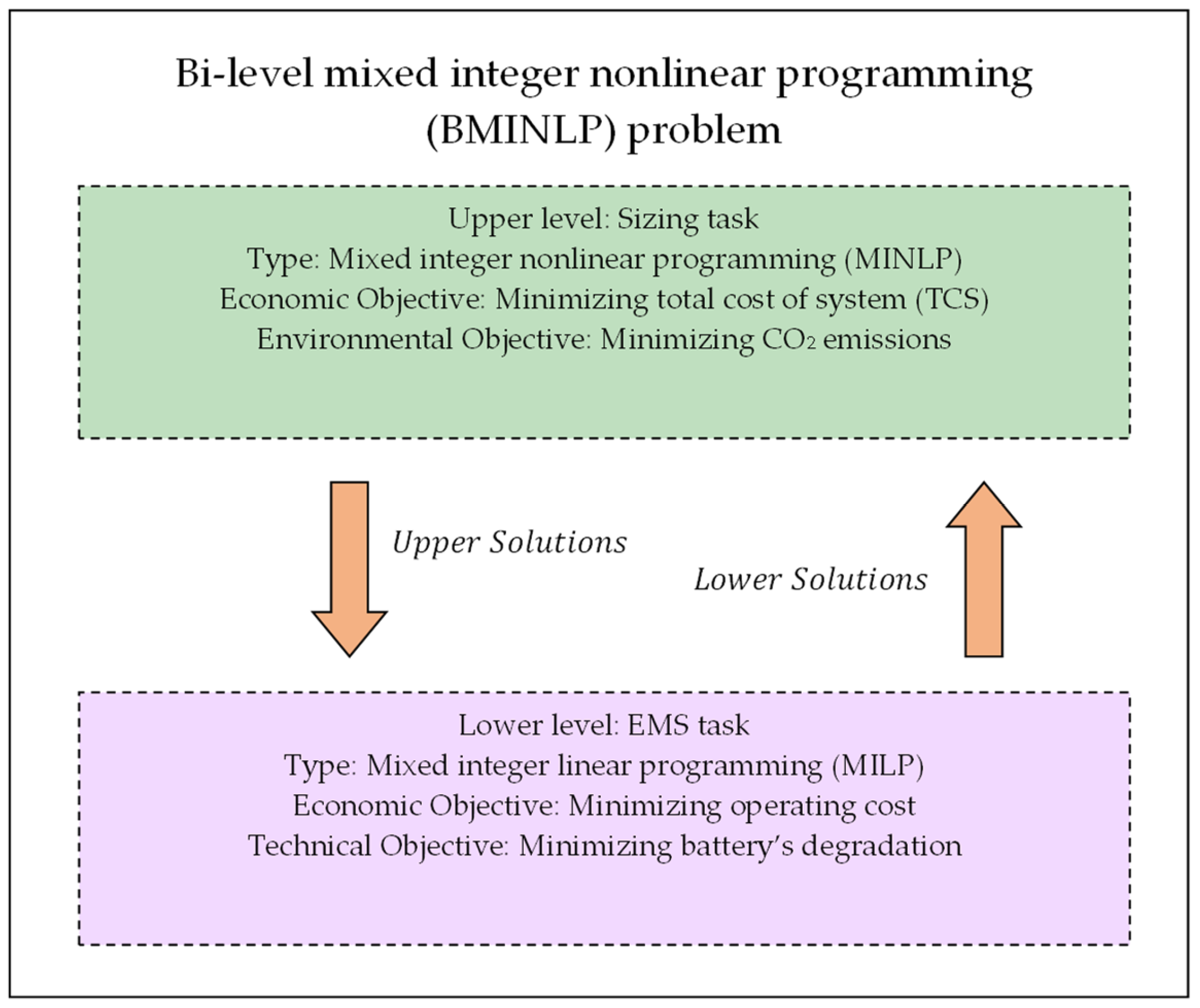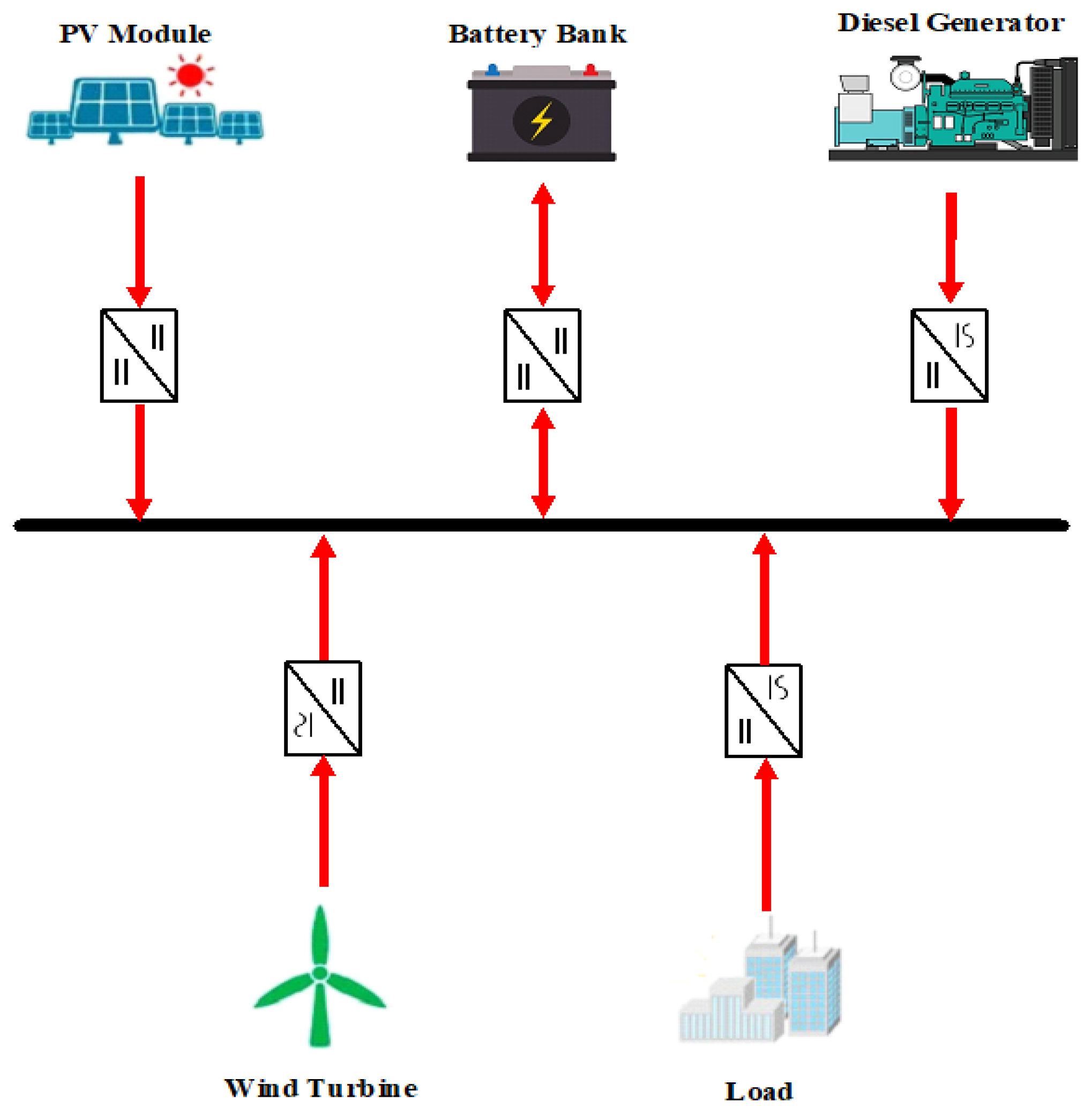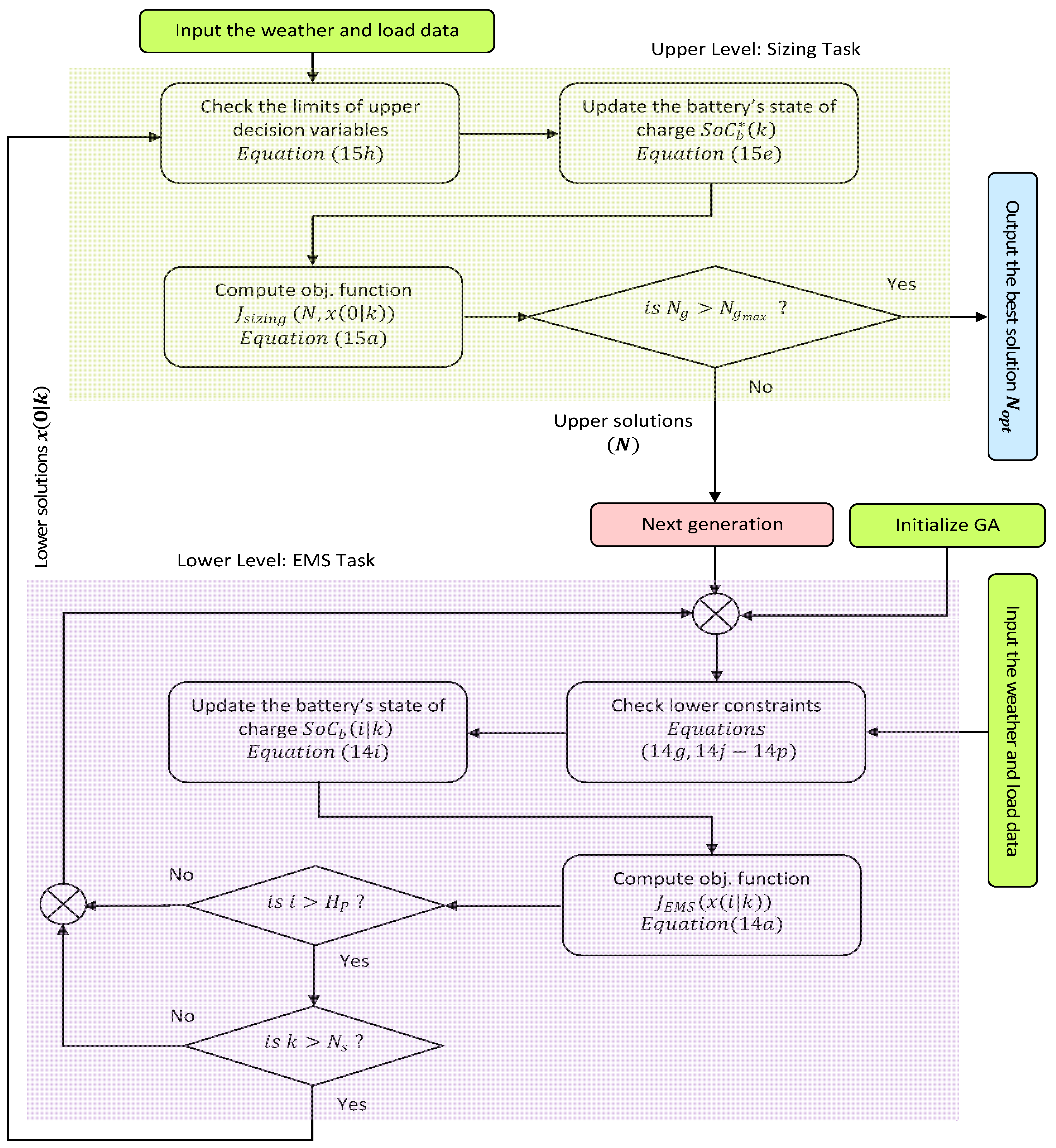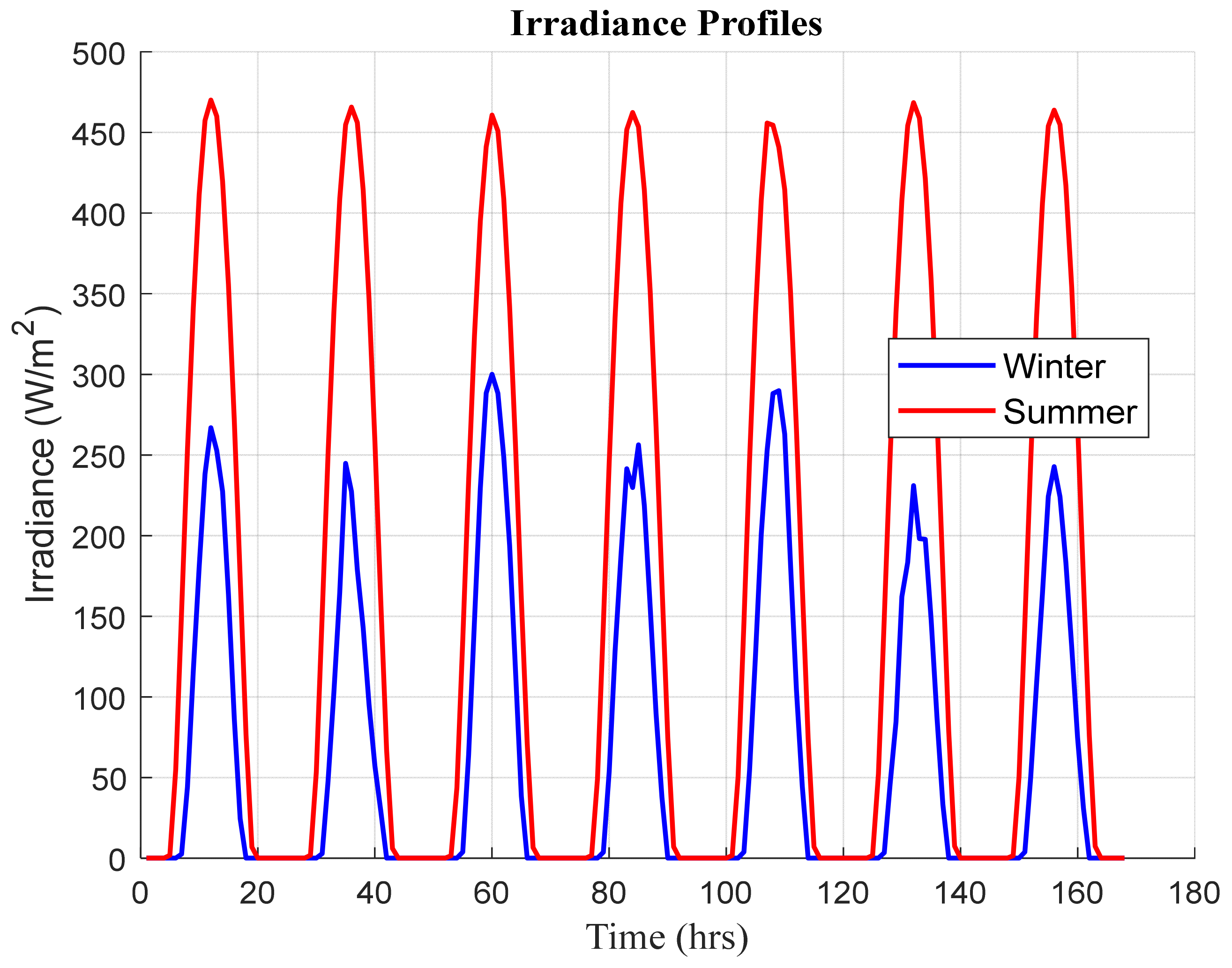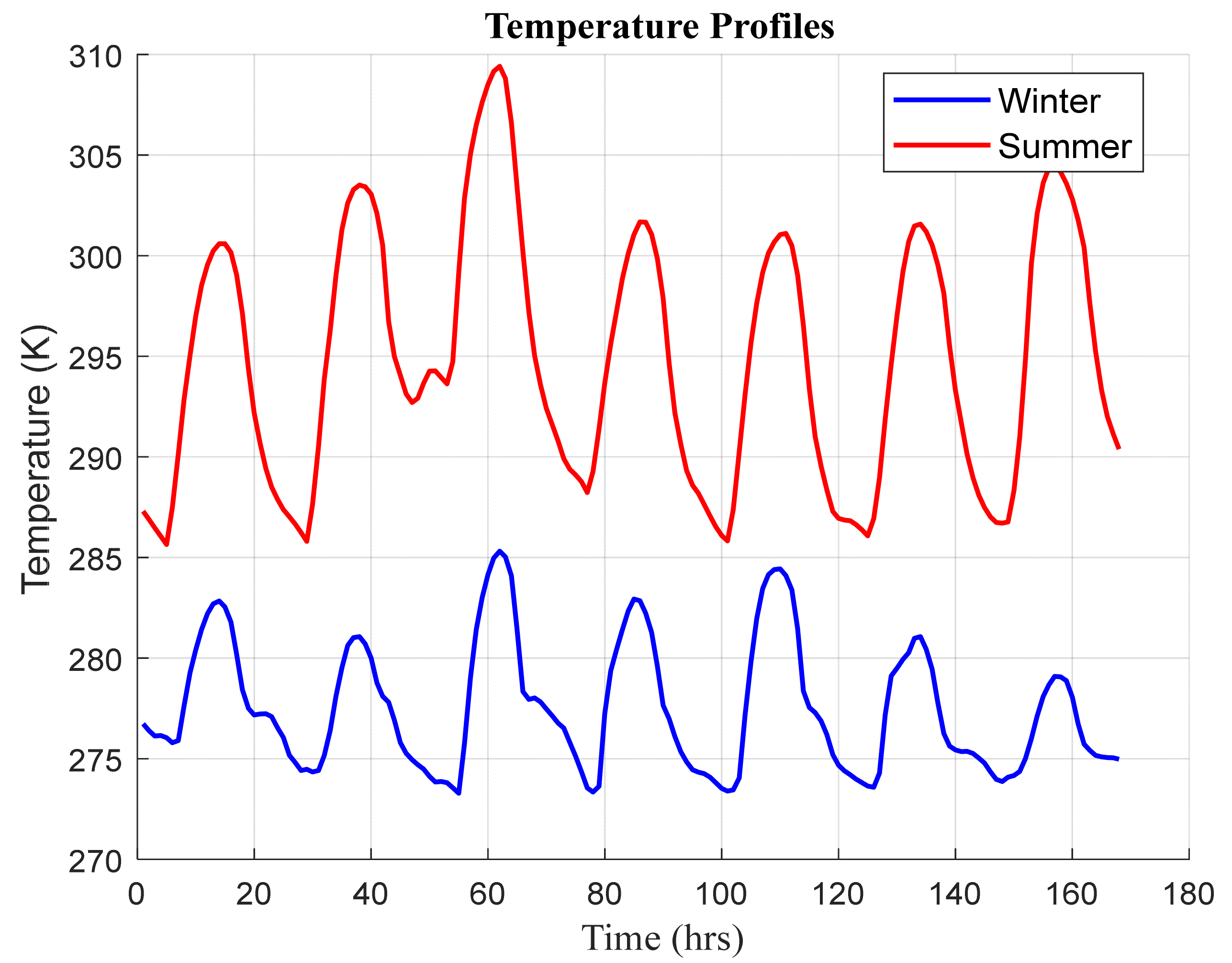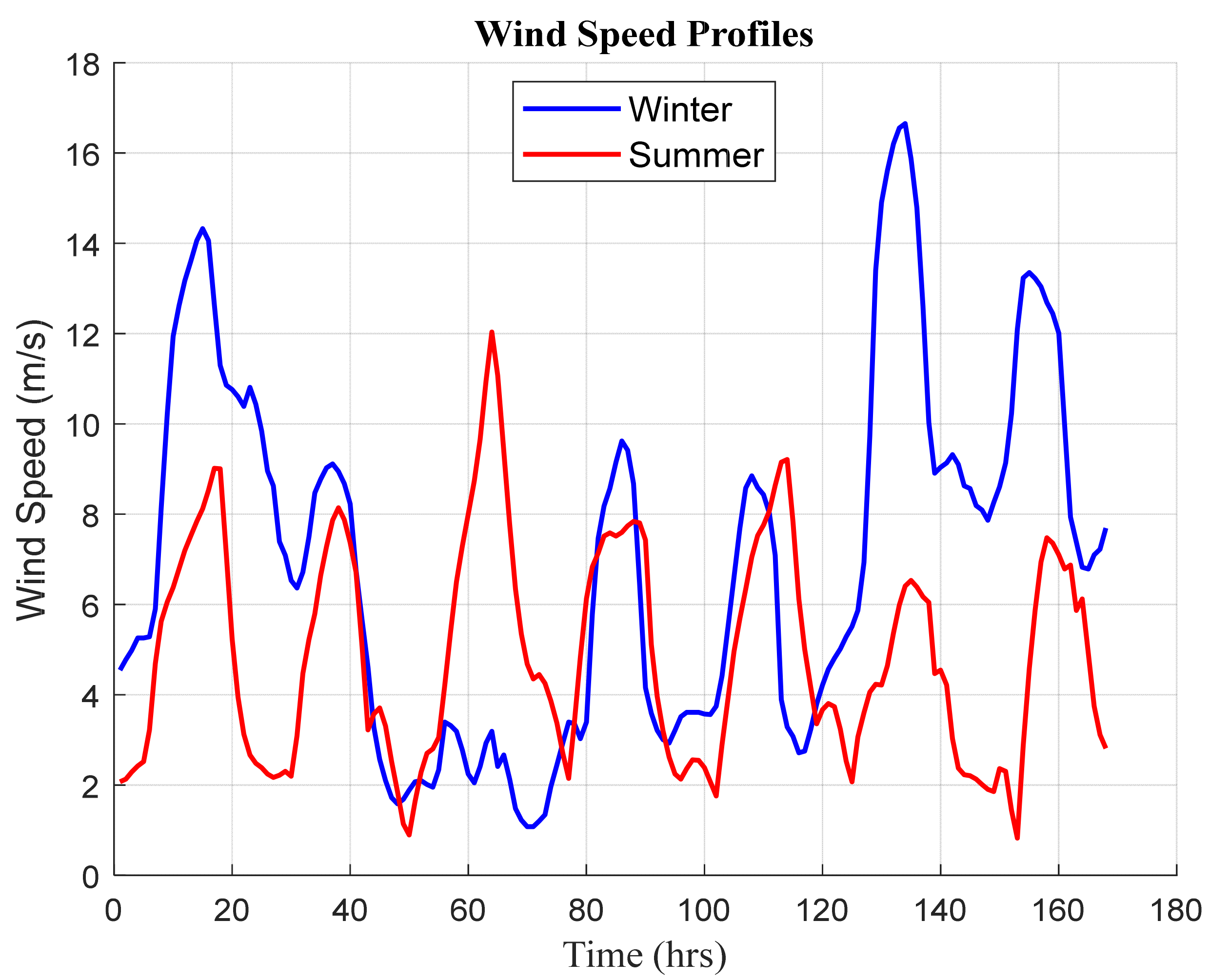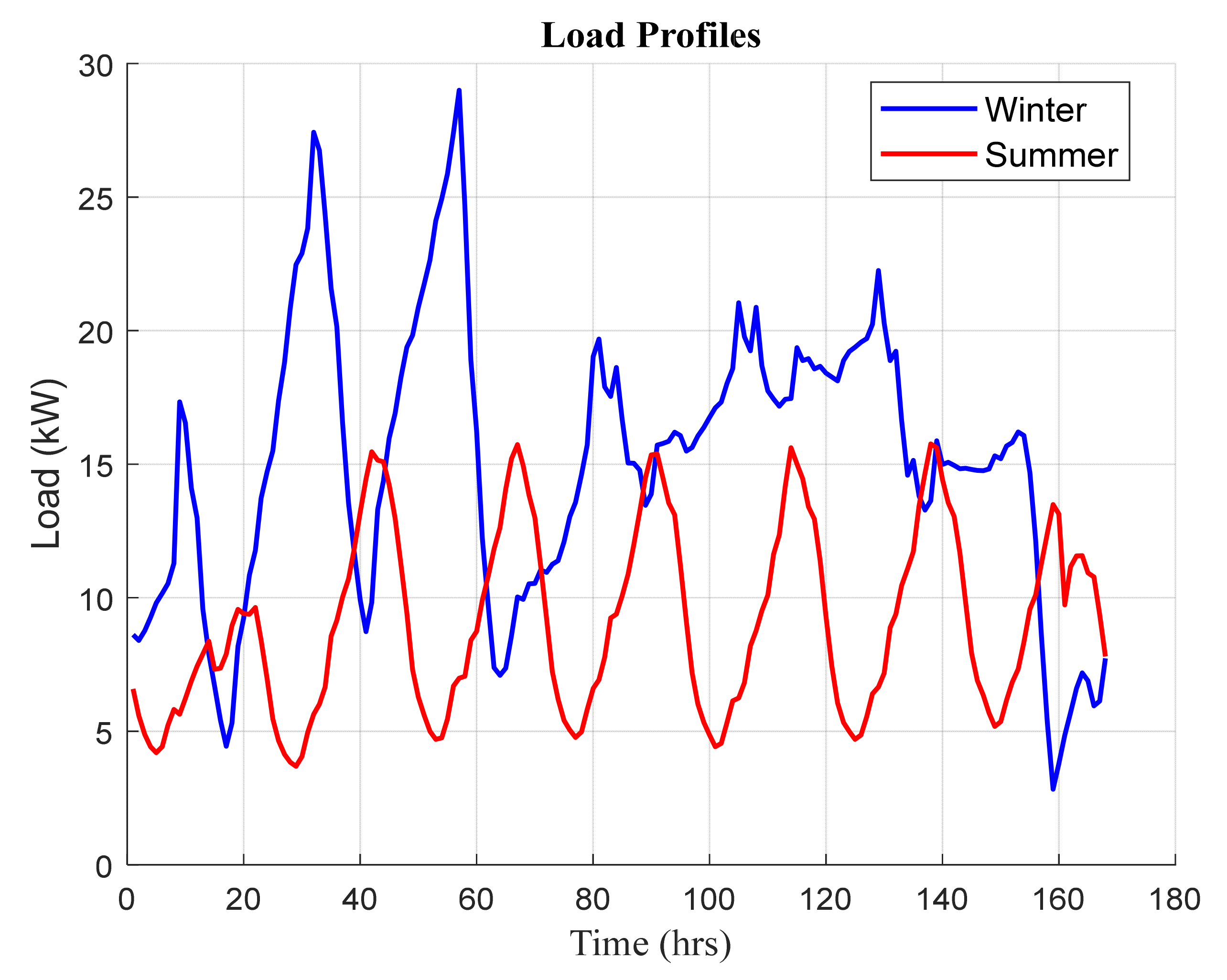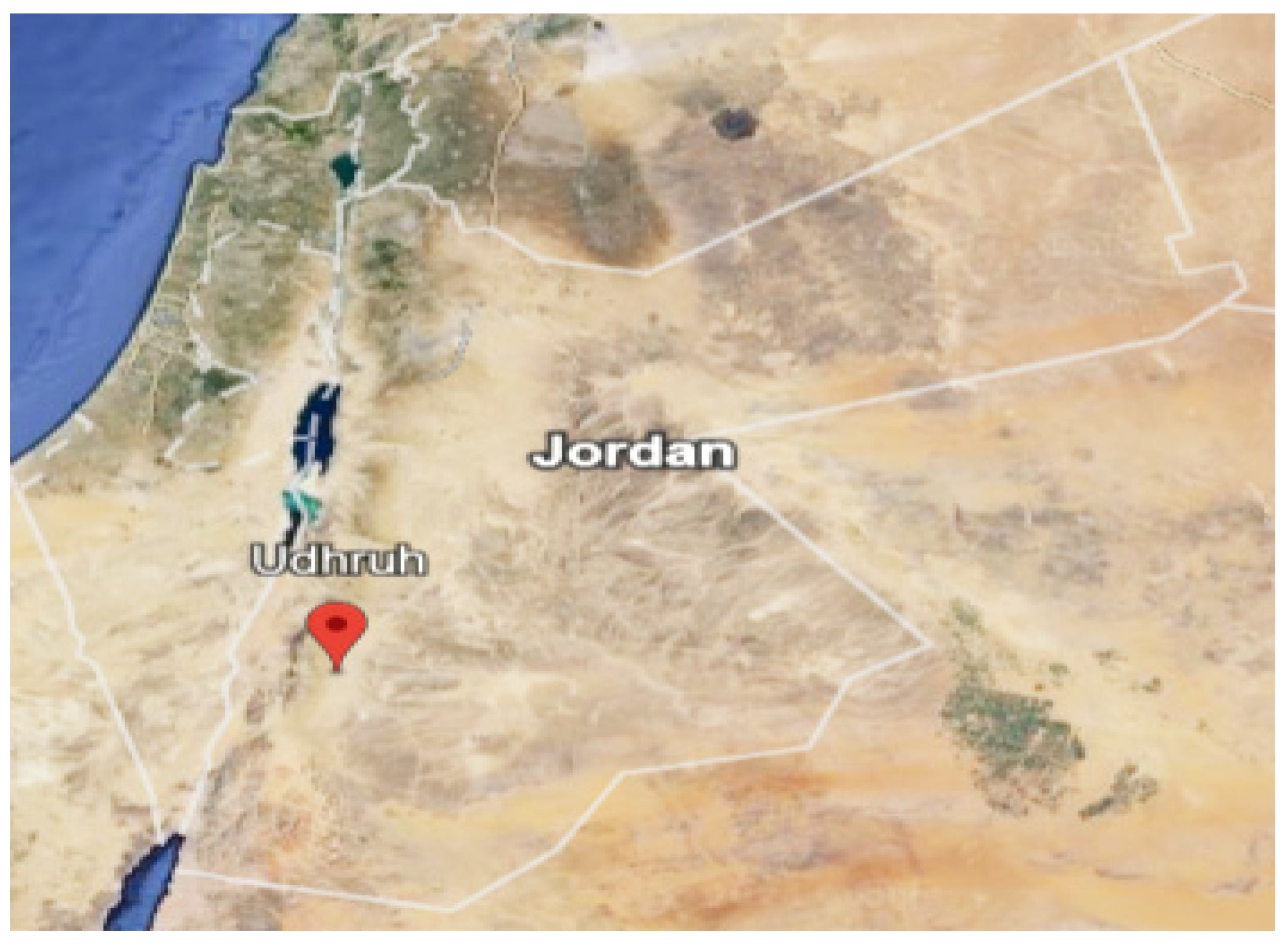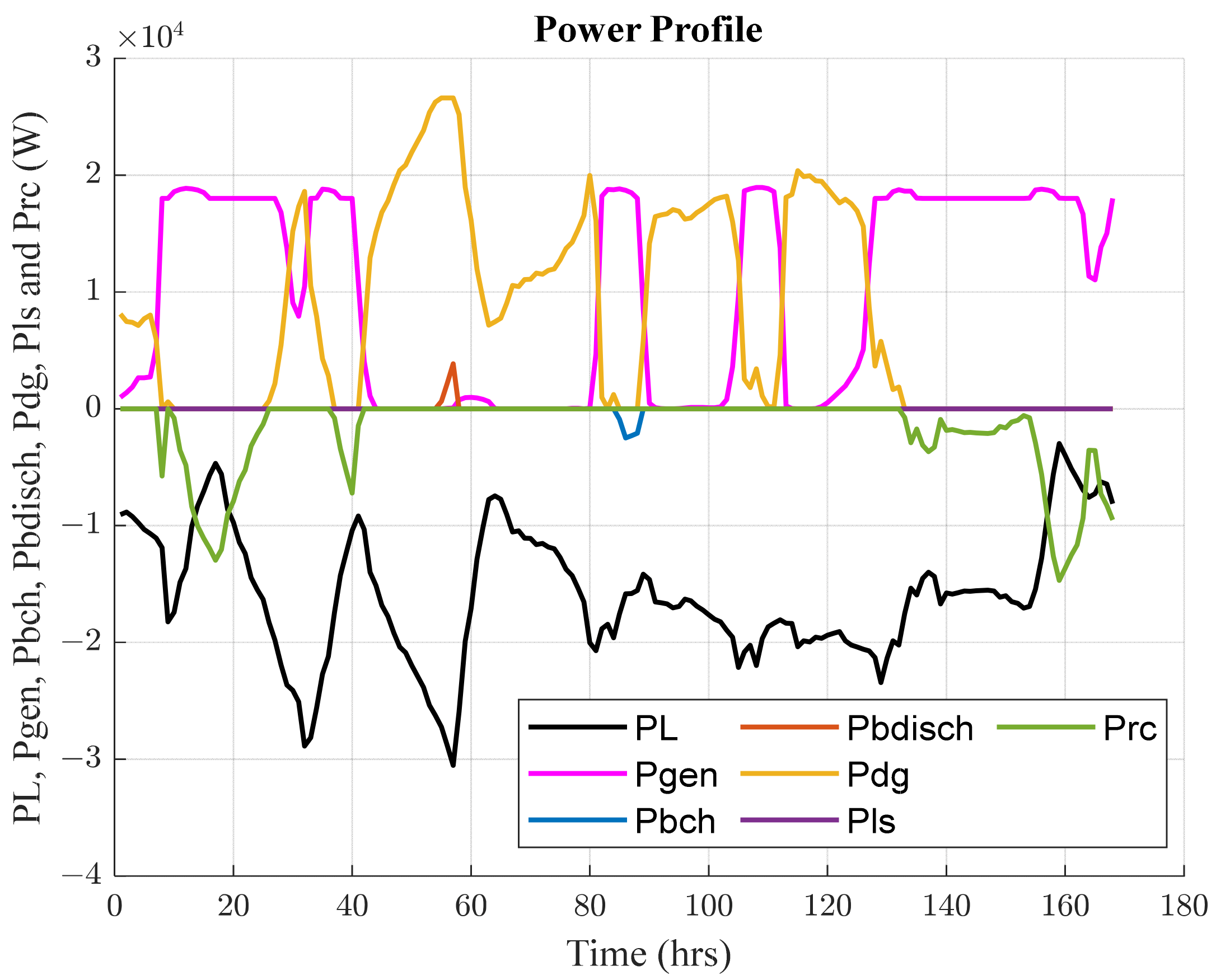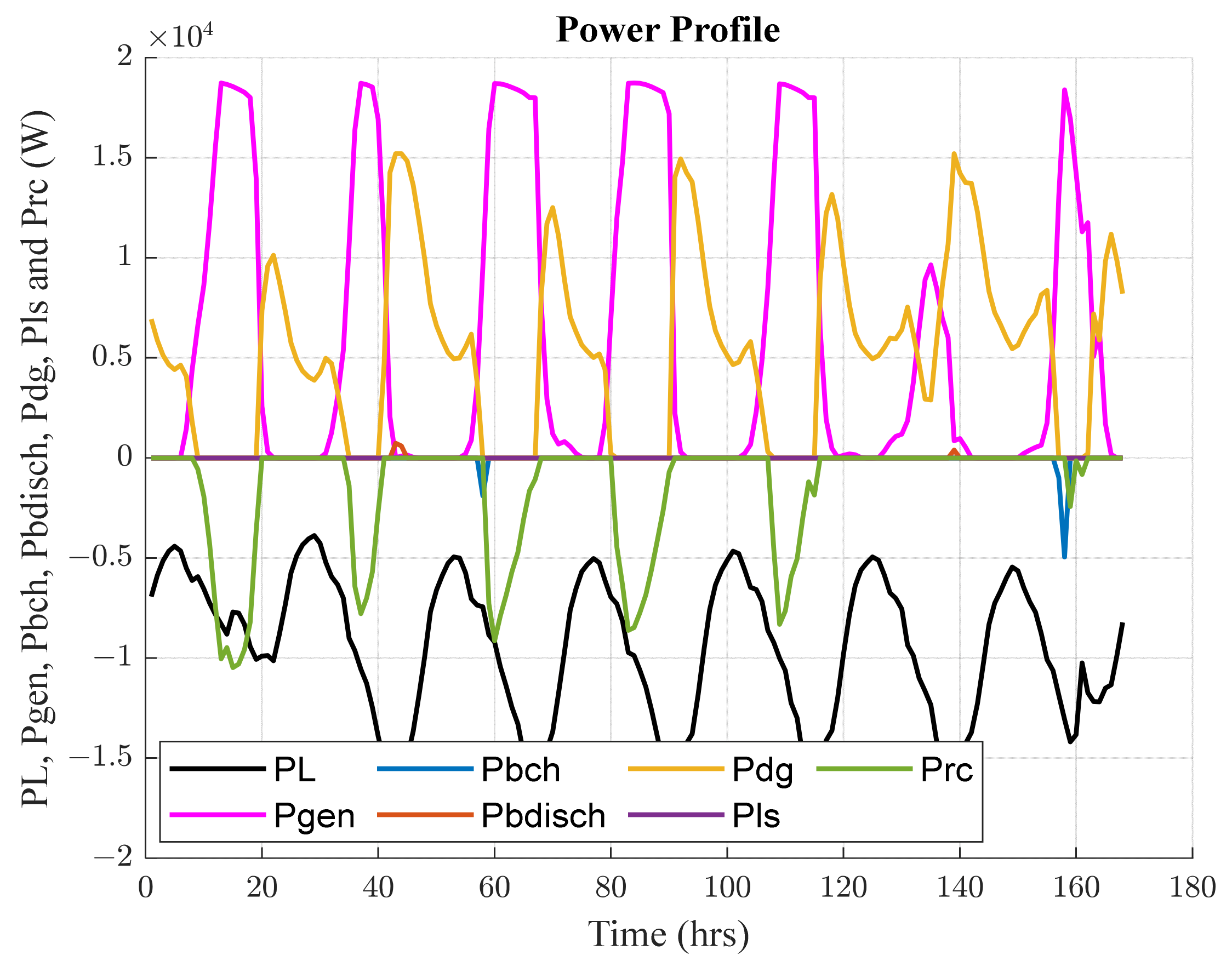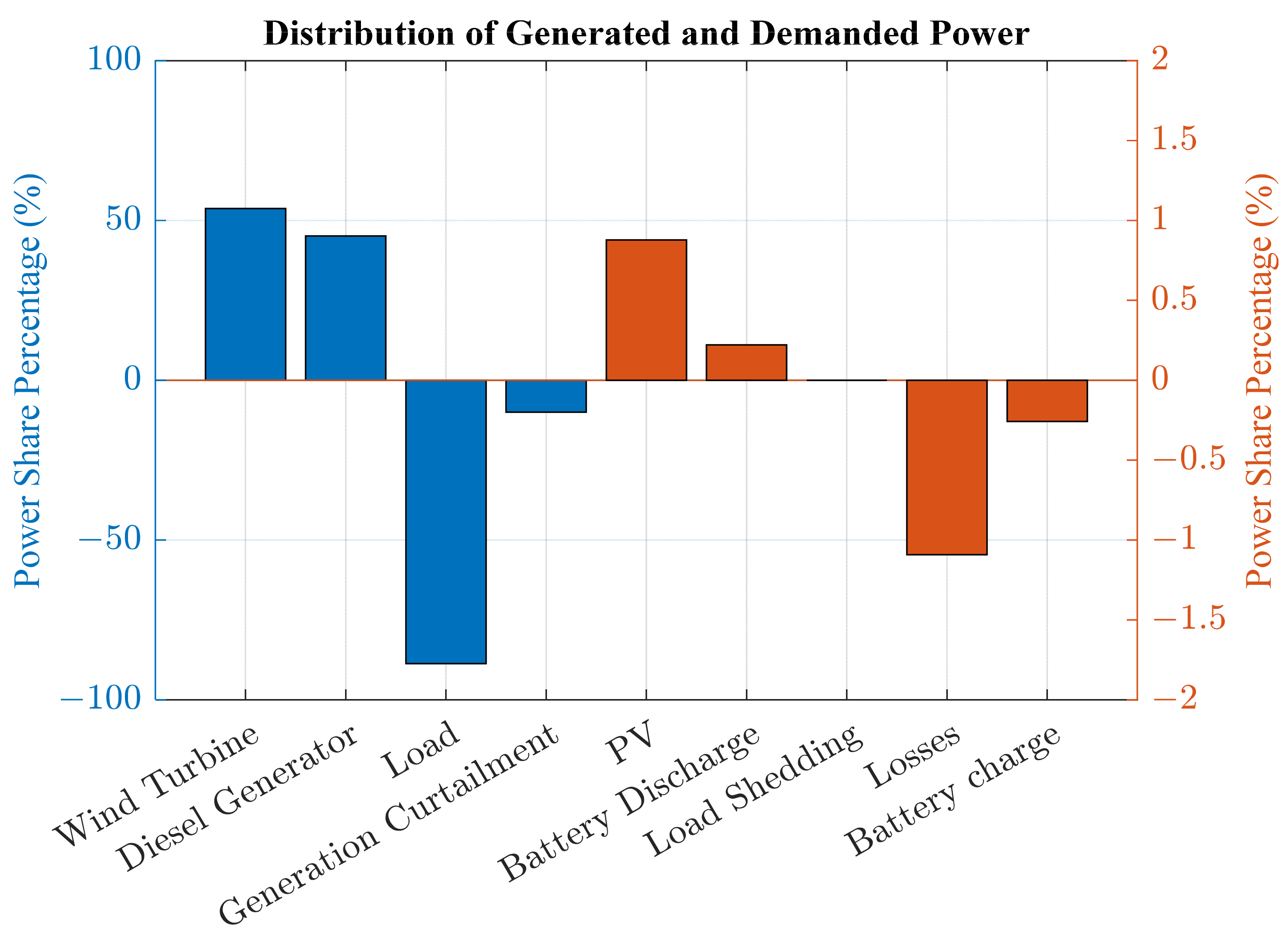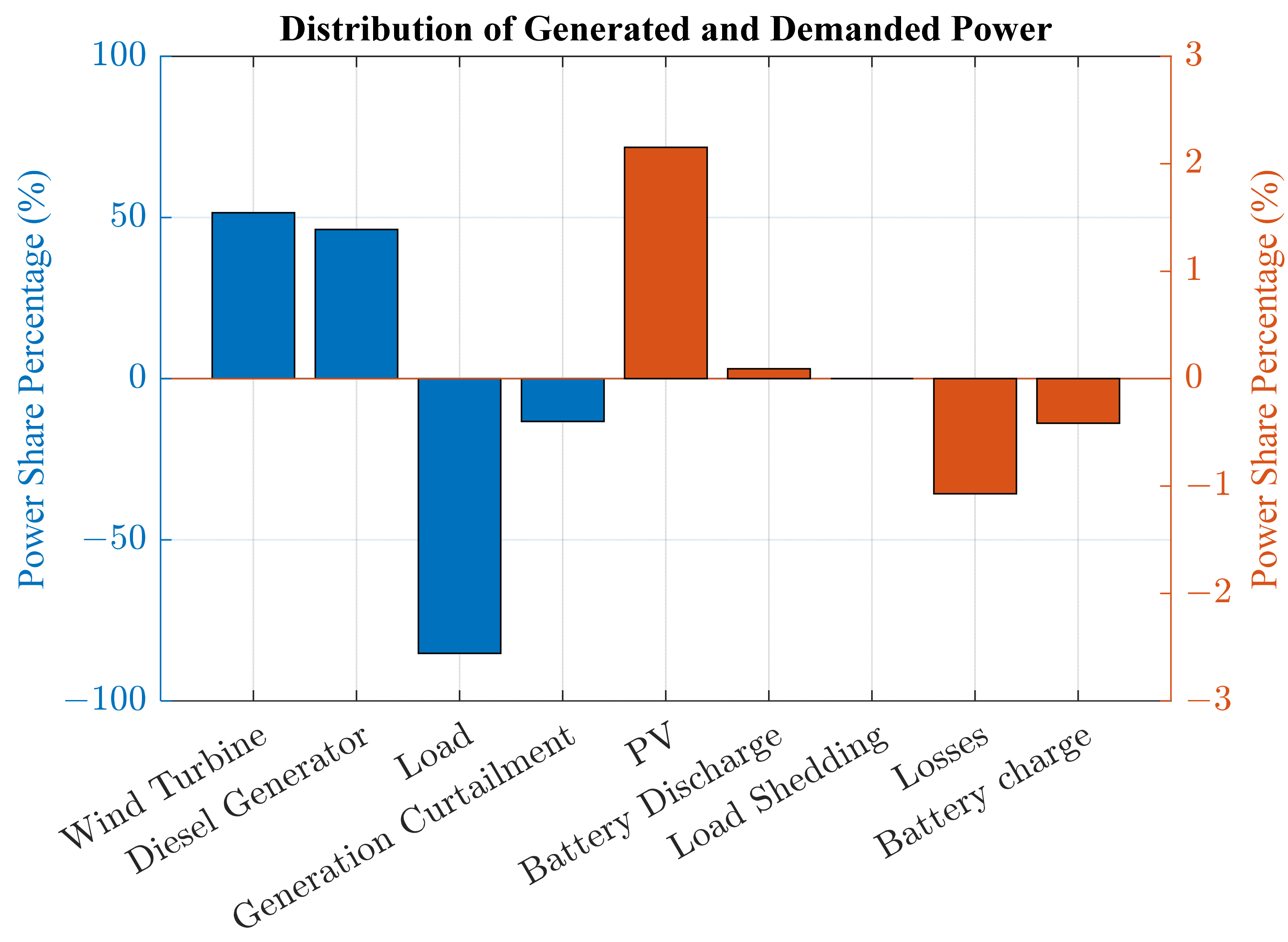1. Introduction
Rising populations worldwide have increased energy demand, which has resulted in stresses on conventional energy resources in recent years. Thus, exacerbating these stresses necessitates greater resource consumption, which results in worsened environmental problems such as air pollution, increased greenhouse gases, and global warming. Globally, the tendency towards reliance on multi-source energy systems has begun due to the environmental concerns mentioned above. Attempts are being made to replace renewable energy sources with fossil fuels and to use cutting-edge technologies in energy storage systems such as batteries and hydrogen storage systems to start shifting towards carbon-free multi-source energy systems [
1]. A hybrid renewable energy system (HRES) is a prominent example of a multi-source energy system. The term HRES is used to describe a system that comprises multiple energy sources, with at least one of them being renewable, combined by one or more energy storage systems. The term HRES is usually applied to both standalone and grid-connected systems [
2].
An existing backup energy system is crucial in HRES; this is due to the nonhomogeneous distribution and unpredictable behavior of renewable resources, such as sun radiation and wind speed, which are constantly fluctuating. These systems act as a safety net for the HRES, which ensures continuity of energy supply in case of energy shortages [
3]. Several sectors can benefit from HRESs. In remote areas, the expansion of these systems in remote areas increases the portion of people with electricity service and lessens their reliance on fossil fuels as an energy source [
4]. The use of hybrid renewable energy systems in the manufacturing sector aids in reducing the high production cost associated with energy usage. Moreover, the energy produced by these systems can contribute to encountering load requirements for cooling or heating purposes [
5]. Additionally, HRESs are further employed in water sectors for pumping irrigation water and powering desalination plants [
6,
7].
The current literature on HRESs is extensive and concentrates particularly on the sizing task [
8,
9,
10,
11,
12,
13,
14,
15,
16,
17]. Bahgaat [
8] proposed an HRES comprising photovoltaic (PV) panels and wind turbines, diesel generators, and battery banks to feed a long-term evolution (LTE) mobile station installed at a far-off area in the 6th of October City, Egypt. The main objectives were to attain optimal technoeconomic performance of the suggested system by achieving the minimum levelized cost of energy (LCOE) and the maximum renewable energy fraction (REF). The hybrid optimization of multiple energy resources (HOMER) tool was utilized to configure and investigate four different configurations: only grid-off PV panels, PV panels and diesel generators, wind turbines alone, and grid-on PV panels. The results revealed that the best system schematic was the only grid-off PV panels based on economic and environmental criteria. The authors of [
10] introduced a grid-off HRES configuring with wind turbines, PV panels, and diesel generators as energy sources in addition to either pumped thermal units or battery banks as storage subsystems. Using the MATLAB environment, a mixed-integer linear programming (MILP) solver was utilized for optimum sizing and energy flow scheduling. The proposed system was targeted to conquer minimum total annual cost, considering a demand response program. This program was established based on instantaneous renewable source accessibility with an active pricing economic model. Iqbal et al. [
13] provided an HRES intended to power a microgrid system of a passenger vessel. Three system configurations were analyzed: (1) PV/wind/battery, (2) PV/wind/battery/diesel, and (3) PV/wind/fuel cell/battery. The system performance was evaluated based on techno-eco-environmental metrics, i.e., energy production, LCOE using net present value, and CO
2 emission. Furthermore, two battery technologies, lead acid battery (LAB) and lithium-ion battery (LIB), were utilized as storage units. The authors of [
14] presented an HRES involving PV modules, diesel generators, and battery packs of a standalone HRES. Three distinct objectives were employed to size the proposed HRES optimally. These objectives were the loss of load probability, CO
2 emission amount, and the annualized cost of the system. The ε-constraint method was used to convert the multi-objective function to a single-objective function, which was implemented by an improved coyote optimization algorithm (ICOA). The proposed method was compared with the particle swarm optimization (PSO) approach and HOMER tool. The findings show that the suggested ICOA-based system outperforms the PSO-based and HOMER-based systems according to renewable contribution and CO
2 emissions indicators. To conclude this part, the studies were focused on using artificial intelligence methods and software tools to construct the HRES. On the contrary, some researchers have used conventional approaches to optimize the HRES, such as probabilistic [
18], iterative [
19], and analytical [
20] approaches, because they are relatively straightforward and simple to execute [
21].
More recent attention has been focused on the provision of EMS techniques [
22,
23,
24,
25,
26,
27,
28,
29,
30,
31]. For standalone HRESs, Kavadias et al. [
3] proposed an adaptive and dynamic intelligent power management control (IPMC) considering the weather variations. The suggested approach was formulated using the fuzzy logic control (FLC) via MATLAB’s Simulink. Using the FLC ensured the balance between the power sources and accomplished the stability and security of the system operation. The simulation results were compared with real-time results obtained from a simulator called OPAL RT LAB. Nair and Sundari [
25] introduced the gazelle optimization algorithm (GOA) to optimize the energy operation within a 24-h control horizon. Moreover, a spiking neural network (SNN) was employed to forecast energy demand using historical data and external factors. The hybrid GOA–SSN approach considered the consumers’ behavior affected by electricity prices to determine the ideal intervals, within the day, for offering them lower prices. Generally, the suggested method is intended to reduce human involvement and leverage advanced bi-directional communication. The authors of [
27] established a method linking model predictive control (MPC) with dynamic programming (DP) for sequential operation scheduling of a grid-on PV and a battery HRES. Three distinguished strategies were introduced: the economic optimization strategy, the grid-power optimization strategy, and the maximizing self-consumption strategy. These strategies were executed experimentally and the associated results were compared with the simulated results. By using a real-date load profile, the authors of [
28] performed an optimal EMS for a microgrid using the economic model predictive control (EMPC) approach. To run the proposed microgrid, the EMS problem was expressed as a mixed-integer nonlinear programming (MINLP) problem.
The authors of [
32,
33,
34] employed a bi-level optimization technique that contains two levels, each comprising an independent optimization task in conjunction with the objective, variables, constraints, and their mathematical nature. The main feature of this method is that the lower task is nested within the constraints of the upper task. In view of that, the sizing optimization sub-problem can be defined within the upper task. It is formulated to configure the system optimally based on achieving the best eco-environmental performance. The sizing sub-problem involves four integer variables, representing the number of units associated with wind turbines, PV modules, diesel generators, and batteries. The lower task expresses the EMS sub-problem, which targets managing the power flows and the operational status storage components. This sub-problem is framed based on the MPC approach with MILP formulation. The upper variables are considered fixed parameters during the lower task-solving process and vice versa. Generally, the entire problem is classified as a bi-level mixed-integer nonlinear programming (BMINLP) optimization problem carried out using the MATLAB program [
35].
Figure 1 illustrates the basic principle behind the suggested bi-level optimization technique. The following are the primary contributions provided by the present study:
A BMINLP problem-solving approach is established by applying a best-practice approach to configure a standalone HRES assimilated by an EMS.
An eco-environmental multi-objective approach is presented for implementing the higher-level task (sizing), while another distinguished technoeconomic multi-objective approach defines the lower-level task (EMS).
Applying a robust EMS-based method (MPC) to improve HRES operation.
The remaining part of the paper proceeds as follows:
Section 2 demonstrates the suggested system modeling. The technique, as described in
Section 3, dives into great detail about the formation of the size and EMS tasks.
Section 4 discusses and displays the relevant outcomes. The conclusion is eventually provided in
Section 5.
3. Methodology
The current study utilizes the bi-level technique to formulate the overall optimization problem. The bi-level optimization technique involves solving two sub-problems with unique variables, constraints, and objectives. The lower-level sub-problem is framed as part of the upper-level sub-problem’s constraints. Generally, the following can mathematically state the bi-level problem [
41]:
where
refers to an objective function representing the upper sub-problem, whereas
is the objective function associated with the lower sub-problem.
denotes upper-level constraints, while the lower-level constraints are represented by
.
In this investigation, each level’s sub-problem is established with a multi-objective function. Nevertheless, the problem can be simplified by converting the multi-objective function (MOF) to a single-objective function using the normalization approach [
42]. Consequently, this technique avoids the prioritization of one single-objective function over the others, as well as reduces the overall consumed time that is required to solve the problem. Mathematically, the normalization process, in conjugated with conventional weighted aggregation, can be expressed as follows [
42]:
where
denotes the nonnegative weight.
and
are the single-objective function and its maximum value. Each sub-problem will be addressed in the following subsections.
3.1. Formulation of Lower-Level Sub-Problem
The lower-level sub-problem characterizes the EMS task within the HRES. Therefore, it aims to operate and manage power flow between the system’s components effectively. In detail, the lower sub-problem is framed as MILP optimization to achieve minimum operating cost and minimum battery degradation. The corresponding decision variables are power flows associated with the battery banks, diesel generators, load shedding, and generation curtailment, as well as the operational statuses related to charging and discharging of the battery. The EMS sub-problem is solved using the MPC technique, which is extensively addressed in [
17]. The mathematical formulation of the EMS sub-problem is given by the following set of equations [
43,
44]:
With
and
, where
refer to operating costs corresponding to the battery banks, diesel generators, load shedding, and generation curtailment.
represents the prediction horizon. The degradation of the battery is expressed by
.
and
denote the capital cost and the discharge factor of the battery. The notation
represents the predicted future value for the instant
for a given actual instant
. According to the EMPC approach, the remaining terms are discarded
, allowing the first term of solution
to be taken into account and applied to the size problem. Likewise, the progression is applied at each instant through the simulation period
.
is the fuel price in USD/L.
and
are energy unit costs in USD/kWh associated with load shedding and generation curtailment, which are selected to be 5.6 USD/kWh [
45].
are the converters’ efficiencies attached to the battery, diesel generator, PV, wind turbine, and load, respectively. The number of units relating to battery, diesel generator, PV, and wind turbine are
.
3.2. Formulation of Upper-Level Sub-Problem
The upper-level sub-problem describes the sizing task in the HRES. Consequently, it aims to efficiently configure and design the suggested system based on eco-environmental objectives. Specifically, the upper sub-problem is constructed as MINLP optimization to accomplish two objective functions: minimizing the total cost of the system (
) and minimizing the CO
2 emissions (
). The corresponding decision variables are the number of units for each element in the system: batteries, diesel generators, PV modules, and wind turbines. The inclusive mathematical formulation of the sizing sub-problem, embedded within the EMS sub-problem, is expressed as follows [
17,
39]:
with
, in Equations (
)
, and in Equation (
)
.
Here,
represent the investment cost, fixed operation and maintenance cost, and the operating cost depending on EMS.
are the capital and maintenance costs.
denotes the lifespan of the HRES. For diesel generators,
is the emission factor, while
is the diesel fuel’s unit conversion factor.
Figure 3 illustrates the solving procedure of both sub-problems as a bi-level optimization problem.
5. Conclusion and Policy Implications
This study was undertaken to design a standalone HRES and run it efficiently. The proposed system combined wind turbines and PV modules as primary energy sources alongside diesel generators and battery banks as backup units. The HRES was intended to supply a residential load. A bi-level optimization problem was established to size the system and optimally manage the energy flow across it. The upper-level sub-problem expressed the sizing task to achieve an optimal economic and environmental performance, i.e., minimizing the total cost and CO2 emissions. The EMS task was set up in the lower-level sub-problem for achieving the best technoeconomic objectives, i.e., minimizing operating cost and battery degradation. The MATLAB environment was utilized to implement the entire problem, formulated as BMINLP. Specifically, the “intlinprg” solver was used to solve the EMS task, whereas the global optimization solver “ga” was applied to carry out the sizing task.
Typical winter and summer weeks were selected as testing periods in the present study. The results were extracted based on the evaluation of certain performance metrics. These metrics included the operating, maintenance, and investment costs, storage unit degradation, and CO2 emissions. The results indicated that the proposed system attained the best performance during the summer period, compared to the winter period, according to all metrics. In detail, the total cost of the system and the CO2 emissions recorded USD 26,447.5 and 958.1 kg during the summer week, while the system approximately recorded twice these values, with around USD 43,055.9 and 1585.79 kg during the winter period. Remarkably, the diesel generator was the most contributing component in the operating cost, with at least 96% for both periods. The aforementioned point explains that the system was not invoked to shed loads in case of low renewable generation. One of the most notable findings to emerge from this study was the appearance of two distinguished scenarios. The first one arose when the supplied power was deficient to the load. In such a case, the energy strategy gave priority to the DG to compensate for the shortage of power. Otherwise, the battery was intervened to tackle the issue when the DG reached its limits. On the other hand, the EMS was invoked to reduce the excess generation by a certain value (curtailed power ), unless the state of charge restriction of the battery allowed it to absorb the surplus generated power.
